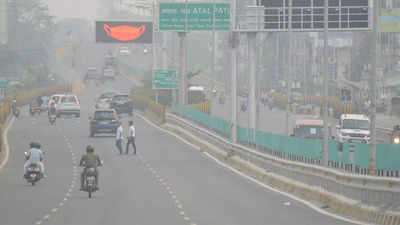- News
- City News
- patna News
- Patna's air quality continues to remain in ‘very poor’ zone
Trending
This story is from January 21, 2022
Patna's air quality continues to remain in ‘very poor’ zone
The city’s air quality continued to remain in the “very poor” category for the third consecutive day on Thursday despite a light drizzle.

Picture for representational purpose only.
PATNA: The city’s air quality continued to remain in the “very poor” category for the third consecutive day on Thursday despite a light drizzle. It is likely to deteriorate further with fall in temperature and decrease in mixing depth, due to which the trapped pollutants in the atmosphere cannot be dispersed.
The overall air quality index (AQI) level of Patna was recorded at 329 on Thursday, up from 316 on Wednesday, as per the Central Pollution Control Board’s bulletin at 4pm, which is the average of the past 24 hours.Prominent pollutants like PM10 (particulate matter less than 10 microns) were recorded at 300 and PM2.5 (particulate matter less than 2.5 microns) at 104 to 189, as per the data provided by the Bihar State pollution Control Board (BSPCB).
An AQI between zero and 50 is considered “good”, 51 and 100 “satisfactory”, 101 and 200 “moderate”, 201 and 300 “poor”, 301 and 400 “very poor” and 401 and 500 “severe”. A “very poor” AQI essentially means that people may suffer respiratory illnesses on prolonged exposure to such air and it may have more pronounced effect in people with lung and heart diseases.
The city’s overall AQI of 329 was the average of pollutants level of six continuous ambient air quality monitoring centres. Among them, five were in very poor zone, including Eco Park (362), Planetarium (357), Patna City (354), S K Memorial Hall (321) and DRM office-Khagaul (321). At these stations, the main pollutant was PM2.5, while PM10 was the main source of pollutant at BIT-Mesra, Patna, which was in the “poor” category with 267.
Ankita Jyoti, senior programme officer at Centre for Environment and Energy Development (CEED), said the minimum temperature has declined in the last few days. As a result, air pollution has increased. “Seasonal sources of pollution also lead to rise in pollutants in the atmosphere,” she said.
The overall air quality index (AQI) level of Patna was recorded at 329 on Thursday, up from 316 on Wednesday, as per the Central Pollution Control Board’s bulletin at 4pm, which is the average of the past 24 hours.Prominent pollutants like PM10 (particulate matter less than 10 microns) were recorded at 300 and PM2.5 (particulate matter less than 2.5 microns) at 104 to 189, as per the data provided by the Bihar State pollution Control Board (BSPCB).
An AQI between zero and 50 is considered “good”, 51 and 100 “satisfactory”, 101 and 200 “moderate”, 201 and 300 “poor”, 301 and 400 “very poor” and 401 and 500 “severe”. A “very poor” AQI essentially means that people may suffer respiratory illnesses on prolonged exposure to such air and it may have more pronounced effect in people with lung and heart diseases.
The city’s overall AQI of 329 was the average of pollutants level of six continuous ambient air quality monitoring centres. Among them, five were in very poor zone, including Eco Park (362), Planetarium (357), Patna City (354), S K Memorial Hall (321) and DRM office-Khagaul (321). At these stations, the main pollutant was PM2.5, while PM10 was the main source of pollutant at BIT-Mesra, Patna, which was in the “poor” category with 267.
Naveen Kumar, an environment scientist and councillor analyst at BSPCB, said pollution level in the city has plunged due to dense fog and cold conditions. “Formation of thermal inversion was also one of the reasons for the rise in pollution. During inversion, cold air is trapped beneath warm air, creating a pocket of stagnated air close to the Earth’s surface. Meteorological conditions are responsible for rise in pollution, while there is no change in anthropogenic activities,” he said.
Ankita Jyoti, senior programme officer at Centre for Environment and Energy Development (CEED), said the minimum temperature has declined in the last few days. As a result, air pollution has increased. “Seasonal sources of pollution also lead to rise in pollutants in the atmosphere,” she said.
End of Article
FOLLOW US ON SOCIAL MEDIA










